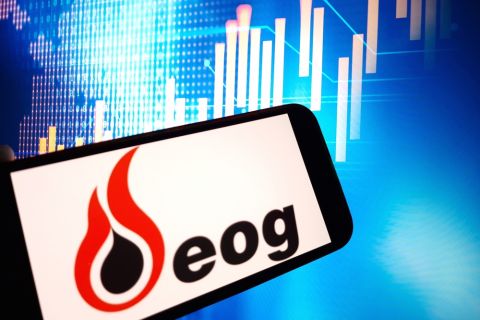
Oil and gas companies could find value and savings in the supply chain using data, experts say. (Source: Wright Studio/Shutterstock.com)
Supply chain woes got you down?
Oil and gas companies sitting on a treasure trove of data might be able to eke out some value and cost-savings to lift margins. But they must know what to look for when sifting through the data and how to bring together different data sources and systems to put all players on the same page working toward common goals, according to a panel of experts speaking during a recent Enverus conference.
“It all starts with data and really understanding where that spend is going—what suppliers, what services, what goods—and really understanding, even from a data quality standpoint, is what I’m looking at the truth? Can I trust that information?” said Leo Oei, vice president of supply chain management for Stonebridge Consulting. “That helps formulate your strategy as well so that you start slicing and dicing.”
The supply chain management conversation focused on source-to-pay, a process in which a company chooses preferred vendors to buy from, negotiates pricing agreements and pays the vendors after receiving the service or product with hopes of controlling spending and increasing savings. Data and technology are at the core of the process. The talk took place as the oil and gas industry braces for potential supply chain and inflation concerns ahead.
Complexity sometimes lies in accounting data, general ledger structures and normalizing information, Oei added. He noted that it is crucial that “the data is telling the same story—whether it’s supply chain, accounting, engineering, operations—so that you have [a] cohesive strategy.”
Nehemiah Katz, managing director of operation services for EQT Corp., pointed out the importance of streamlining in data-driven decisions along the supply chain. Companies may be able to see the potential of cost inflation on the horizon and as a result make better-informed decisions.
“It’s important to … make sure that we’re creating data relationships only where they’re going to add value and where they’re going to inform decision making,” Katz said.
Having multiple data sources, however, is a challenge today for the industry, according to Dustin Ellis, supply chain manager for Laredo Petroleum.
“How do you build those relationships and tie them all together and then make a meaningful dataset that can be used for decision making [and] planning,” he said. “Right now, the sky’s the limit. … Data is out there. Now it’s just kind of wrangling it all up and putting it together into an understandable usable format.”
Supplier management programs and having a solid onboarding process are key, they say.
Laredo has a tight vetting process for new suppliers, Ellis said, noting the company has about six levels of approvals before the supplier is onboarded with the company. “The value of that is on the back end,” he said.
The company also has a cross-functional process that prohibits a supplier from the accounts payable software it uses until the master supply agreement (MSA) has been executed. “We can’t control what happens in the field, but this has really given us a lot more visibility when the supplier sends an email saying, ‘Hey, I can’t invoice. I need to invoice you.’” Ellis said. “We know that obviously they’ve been working for us and we better get that MSA and/or work order in place. By not allowing them to invoice us at that time, that kind of gives them the incentive to get the paperwork done on their side, too.”
Ellis admits that it is not the “perfect trap,” or safeguard, but it’s an improvement from the past.
For EQT, accounts payable software and MSA are integrated into the digital work environment along with authorizations for expenditures (AFE) to track costs.
“It makes it a little bit easier to kind of manage end-to-end,” Katz said, speaking from the risk management perspective. Attention is paid to compliance and performance. “We sit down with them quarterly and have [a] review of performance.”
Operating on a three-year schedule, Katz said the company is able to forecast based on in-depth discussions with suppliers and set targets based on project-specific requirements. “All of that is a function of the way that we have set up the data structure and the organization’s data lake,” he said.
Collaboration is also key as Dan McDonald, senior director of source-to-play for Enverus and session moderator, said. “The more you collaborate with suppliers the better value proposition you get, especially the materials, because you don’t know if a supplier or manufacturer has excess capacity that you can utilize.”
Having a platform that enables operators to expand on MSAs and get more on the commercial performance of suppliers and vendors is also important, Oei added. It goes back to whether they are executing to expectations to maintain value.
In addition, Oei pointed out that field ticket management and account payable software such as Enverus’ cloud-based OpenTicket and OpenInvoice can shed light on potential areas of risk.
“For example, if they’re not submitting their invoices from an operational date and it’s taking them 30 to 60 days to invoice you, they may be in a cash flow crunch,” Oei said before flipping to the operator side. “Are we approving our invoices in time to pay? Are we approving the field ticket in time for them to invoice? ... We have platforms. We have good data now to be able to take action on it. Those are good measurements that you can start looking at to help suppliers manage their risk around cash flow and financial stability.”
There are internal benefits for operators as well. If the average payment cycle to the time a ticket is submitted for payment is known, an operator can forecast out 60-90 days what its cash flow may look like, Oei said.
“I think we’ve got a lot of great technology out there and a lot of good information. It’s really how do we then leverage that and work together with all the different stakeholders in the company to be able to execute and get the most value out of it,” Oei said.
“We’ve already come a long way to be able to get value much easier, much more efficiently, and we’re doing it with much smaller teams. … It’s important that we leverage technology as much as possible and bring in our stakeholders to understand the value of that information and speak the same language,” he added.
Recommended Reading
Uinta Basin: 50% More Oil for Twice the Proppant
2024-03-06 - The higher-intensity completions are costing an average of 35% fewer dollars spent per barrel of oil equivalent of output, Crescent Energy told investors and analysts on March 5.
Canadian Natural Resources Boosting Production in Oil Sands
2024-03-04 - Canadian Natural Resources will increase its quarterly dividend following record production volumes in the quarter.
Kissler: OPEC+ Likely to Buoy Crude Prices—At Least Somewhat
2024-03-18 - By keeping its voluntary production cuts, OPEC+ is sending a clear signal that oil prices need to be sustainable for both producers and consumers.
Buffett: ‘No Interest’ in Occidental Takeover, Praises 'Hallelujah!' Shale
2024-02-27 - Berkshire Hathaway’s Warren Buffett added that the U.S. electric power situation is “ominous.”
The One Where EOG’s Stock Tanked
2024-02-23 - A rare earnings miss pushed the wildcatter’s stock down as much as 6%, while larger and smaller peers’ share prices were mostly unchanged. One analyst asked if EOG is like Narcissus.






